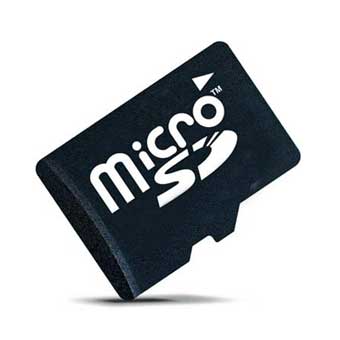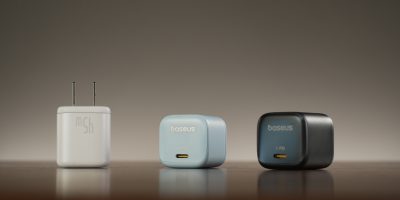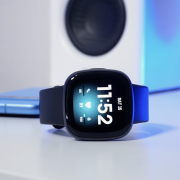
With manufacturers focusing on the speed and number of cores a smartphone’s processor features, megapixel numbers, and network technologies like LTE, the performance of an Android handset should largely be based on its hardware, right? Wrong, according to a new study undertaken by researchers at the Georgia Institute of Technology. The type and brand of microSD storage installed in the device could just as well be the culprit. Their study that found that flash storage often accounted for a 100 to 300 percent drop in performance. In one instance the numbers dipped by an astonishing 2,000 percent.
Hyojun Kim, a doctoral student at the College of Computing at Georgia Tech, headed up the research and concluded that flash storage technology simply isn’t keeping pace with its counterpart mobile hardware. The source of the slowdown in applications varying from Facebook to Google Maps is the poor handling of random I/O data from the software.
A possible solution rests in phase-change random access memory (PRAM), which could be used to better manage random data writing. A relatively quick and easy way to increase the performance of a current microSD card is by reorganizing its file subsystem and otherwise keeping storage space neat and tidy. For more on the technical aspects and the science behind it, check out the Usenix link below to read the entire text of Kim’s paper.
[Usenix via ComputerWorld]











I know in cameras SD Cards do make a lot of difference in performance of the camera .
what about the nexus
this
Nexus uses internal memory, not flash memory on an SD card. This is actually the reason iPhone and many other phones are moving towards larger chunks of internal built-in memory. Its just a better experience.
Granted offering the option of cheap upgrade with an SD card slot should also exist.
It may be internal memory but it’s still the exact same stuff that is in an SD Card, only it is soldered to the motherboard.
Built-in internal memory is far faster than SD cards… even the really fast ones.
Its not so much the type of memory (of course improving that will help) but the interface with it.
it is NAND memory, yes, but it is a different application of it, it works much better when built in because it has more connections and therefore larger bandwidth, removable memory limits the functionality of NAND memory
Sorry, but there is a big difference on them. SD for now is nowhere near the speed of internal ram. The interface is the difference.
I can tell the difference if I put anything slower than Class 6. Class 4 is usable but class 6 is ideal. Fortunately most recently released phones have plenty of internal storage so its not as big of a deal as it used to be.
aaand what do you think they put in stock phones?
hint: class 2-4.
not what he is saying. phones have internal NAND memory now, not memory cards like what your talking about… the SGSII comes in either 16gb or 32gb flavors of INTERNAL memory, these are not 16gb or 32gb memory cards they are NAND memory units
Thank you.
Sounds like a need for an SD card optimization app ;-)
I tried telling everyone there were positives to not having a microSD card-enabled device. “Oh but the Galaxy Nexus has NO removable storage?! That’s an outrage! There is absolutely NO reason to not have one! You’re an idiot if you buy this phone!”
The flash memory in the Nexus is identical the the flash memory that comes on and external SD Card, there is no speed advantage/disadvantage to internal vs. external.
yes there is.
The Galaxy Nexus gets 50MB/s read speeds, while the Class 10 sd cards get.. well 10MB/s
Which makes no difference when the speed sensitive data is stored on the internal storage. The expandable storage is still quite handy for fitting large amounts of data that doesn’t have to be fast (like the 30GB of music on my SD card). Not to mention the fact that 10MB/s (~80Mbps) is still faster than ANY mobile internet connection I am aware of (for those who claim the cloud can replace my SD card).
When you have a sd card slot, im pretty sure everything gets a bit mixed, like you only have 1 gig for apps, but the nexus everything is in one drive just like iphone.
Wifi counts as mobile Internet and may be able to beat those speeds
Even if the internal memory was faster (which it very well may be, due to bus speeds, higher quality flash, etc.) the OS and apps can still be stored on the internal storage, leaving the SD card open for data that doesn’t require lots of speed (such as music, photos, and other media). To use a study like this to imply that microSD slots are a bad idea is ignorant at best, and intentionally misleading at worst.
So long as the user manages their storage properly (not use it for the OS or the storage of apps that require speed) the microSD slot offers NO performance disadvantage, and the option to store additional media.
BTW, my class 10 SD card MAY not be as fast as my phone’s internal storage, but it is still much, much faster than my spotty 3G connection for those who claim the cloud is a viable alternative to expandable storage.
ditto. the dude agrees.
i 101% agree!!
i think problem only happen on those device with limited internal storage like my HTC Desire. Putting application on SD Card definitely will reduce the phone performance :(
I not facing this problem after upgraded to Galaxy S2 :)
except that Google/Samsung engineered that in the memory in the nexus(and all other hardware in the device) to work in perfect harmony with the OS. So not really the same. In any case pulling data resources from external storage is always slower. That’s why in never understood they crys from android users for apps to sd. Besides other then for bragging right how here’s ever upgraded there storage on there phone anyway. I’ve owned 8 smart phones and never needed to.
I have on every phone I’ve ever owned
So, name me a reason not to have an SD slot…
Because when it’s not included manufacturers include more and faster onboard NAND
Logic fail.
Having the OPTION to ADD more storage is not a negative. Even if you choose to use a slow class2 or 4 microSDHC card (vs class 6 or 10), having the extra space available for not-as-often-accessed content is a plus, since the internal SD takes priority for system and oft-accessed data anyway.
The one and only positive for not having an external SD slot is to save a tiny sliver of space in the phone (debatable) and tiny bit of manufacturing money. It’s mainly the carriers who hope to benefit from people depending on sucking down data from the cloud all the time.
[edit: and, fwiw, I’ve benchmarked the internal and external SD in my SGS1, and they’re pretty much equal @ 8MB/s for read and write. (my ext SD is a $50 “class10” 32GB Lexar that should be getting 10MB/s, but doesn’t quite cut it)]
[edit2: oh, and if phones with microSDXC (vs SDHC) slots don’t debut at MWC I’m going to shoot somebody. It’s high time for official 64GB+ card compat and files larger than 4GB with exFAT or extfs)]
Google knows this and its why they moved from SD storage to completely internal.
The flash memory in the Nexus is identical the the flash memory that comes on and external SD Card, there is no speed advantage/disadvantage to internal vs. external.
unless it’s a higher class..
Not necessarily. To get a higher class rating (sequential) manufacturers sacrifice random access speed.
doesn’t really do much for the conversation unless you have a specific need.
higher class isn’t all its cracked up to be too. Google some tests done on SD cards for cameras. You’ll find that quite a few boast about how high their cards are rated, but real world tests show differently.
Basically, don’t just go out and buy a higher class card without doing the research, and getting a reputable brand.
Wait…what?
How do you have a 100% drop in performance? Wouldn’t that mean the phone is not even functioning? Am I misunderstanding the wording?
Well a performance drop means slower speeds. So if 100% performance is doing a task in 2 seconds, maybe a 100-300% drop means increased time to complete task by 100-300%, so 2-4x slower than normal? So a 2 second task goes to taking 4-8 seconds? That’d be my guess.
Does a 200% reduction in speed mean that the process is now going at 100% speed, only in reverse?
If you take a brick and make it 5 time lighter, it floats.
Yeah, the ravings of a language pedant, but precise communications let us do more and better things together. Even 300% more, in some cases.
performance and speed are not equivalent. however, performance is often measured by speed. if opening the gallary app takes 2 seconds during normal 100% performance, than a 200% reduction in performance could mean that it now takes 6 seconds to open that gallery app.
Not true. Speed is expressed as a ratio of distance (or actions) to time.
When we reduce speed we are reducing the numerator, not increasing the denominator. So if you reduce your speed of 60 miles per hour by 100% you are subtracting 100% of 60 from the denominator, and you wind up with 0 miles per hour.
Some people discuss reductions as if we are changing the denominator. So a 300% reduction in speed would mean multiplying the denominator by 2 or 3.Why does it matter? Because if you’re ambiguous about whether you’re changing the numerator or denominator you get ambiguous results (think of calculating a 90% reduction in speed – do you want to say 6 miles per hour, or 31.58 miles per hour?).
Excellent guess. Comment sections need more people like you. And Gawker too for asking reasonable questions to improve their knowledge of the world.
People no longer use standard references. I regularly read that something is “200% slower.” That is real nonsense. How about just making it read “50% as fast?”
The same way you have a 100% increase of something, only in reverse. If it took 1 second before it now takes 2 seconds, 3 seconds would be 200% drop.
Now I know why my droid bionic takes takes 20 minutes to delete 10 songs -.- its my class 2 card.
I thought this was a previously known fact….Anyways I still want a micro sd card slot on my phone.
“I still want a micro sd card slot on my phone.”
^This!
My Galaxy Nexus agrees
Don’t they still use flash even for internal storage?
Hey guys, internal memory is flash memory. Usually class 10. All you have to do is research the phone’s flash chip specs.
“the performance of an Android handset should largely be based on its hardware, right? Wrong”, excuse me if I am wrong but is not memory still considered hardware???
not in the way most people think of hardware specs… CPU, GPU, Screen display, RAM, Camera MP count, these are typical hardware specs
I thought the same thing when I read it, memory is hardware
This is one post where the comments are at least as interesting as the post.
I have a Droid Bionic and when it boots, the SD indicator sits there for a looongg time. Seems like most commenters are saying we need a class 6 or better SD. Any ideas how a n00b can tell?
Most SD cards that come with the phones are Class 2 or 4 (more often than not, 2). It should also have a 2/4/6/10 on the card (except maybe on stock cards) that indicates what class it is.
No one knew this before? Anything that doesn’t require power to maintain bits is going to be incredibly slow. This is because you are moving small bits of molecules to create a circuit specific to the memory content. Its like sending a letter instead of emailing a letter. One requires electricity to exist, the other does not.
Sorry but it does require electricity to send a letter, lots of it
Old news for anyone that messed around with a Nook Color. :P
For random read/write a decent Class 2 and Class 4 can be vastly faster than a Class 10 btw. For every day use, this is absolutely king for performance.
no they can’t, class is determined by read/write functionality, if they run faster then they are classified higher. your statement makes no sense.
Sadly, you are both wrong. Since there is no regulation, requirements or even testing to prove what a “class” speed rating is, you are simply hoping the manufacturer isnt lying about the speed. And guess what, they are!
Trust peer reviews, not marketing claims…..
End of class kids!
true there is no enforcement but class is “supposed” to be read/write representation, just because noone enforces it doesn’t mean that isn’t what the numbers are saying. a class 10 is SUPPOSED to read and write faster then a lower class card, just cause they can lie about it doesn’t mean that isn’t what the classes are stating
What? A class 10 card is always faster than any class below it. The higher the class the faster it is.
I thought class was determined by the sequential speed of read/writes? So the claim that @TongueDar:disqus is making could be accurate. It could be possible that a lower class SD card could read/write faster in a random acess scenario (such as running apps from the SD card) as opposed to a sequential assess scenario (such as music, docs, movies, etc).
Higher class always faster
Again, doesn’t it depend on how you are measuring the speed? Maybe a class 10 read/writes at 10MB/s in a sequential test, but maybe when you’re doing a test to measure random-acess read/writes, it doesn’t perform as fast.
I believe @fonseca898:disqus knows a little bit more about this then I do, since he also mentioned something about sequential vs. random-acess so maybe he could shime in.
Or you could look it up
I’m…believing this to be a fact. Regardless, of the fact having sd cards is a huge plus…they take forever to load, to load pics/videos, and make booting time longer.
They found the rate limiting step? That was there already. Just like pcs and ssds vs HD.
Ssds boot faster load faster respond faster
Nothing new just proving the obvious.
Im going to test this theroy right now by removing my external card and check boot speeds, launch speeds, etc, etc
Probably not going to make a difference on the boot unless your keeping system files there
Before i got my galaxy nexus I had the nexus one. It came with a class 2 sdcard. I had cyanogen installed so 70% of my apps were on sd. Then I bought a class 10 sdcard and my phones performance skyrocketed. Now I know the n1 wasn’t capable of really using a class 10 card. I think anything above class 6 gets no boost in performance but it was worth the couple extra bucks to guarantee constant high speed thoroughput. Storage is an obvious place to look for performance issues and its probably the easiest for manufacturers to address
Ohhhh, that explains alot then with my smartphone
Ive always thought this, my X10 came with a class 10 (i think) 8GB card, I replaced it with a cheap 16GB lowest class card and REALLY saw the difference, but didnt mind cause i really didnt have the money to splash on a faster card.
One of the reasons I never move apps to SD.
one of the reasons you need a better SD card.
Removable storage (SD cards) are still a must have.
Just a few observations from a phone technician. NO, a real one. First of all, having external storage is never a bad thing. Obviously, the higher the class of card, the better and the higher the capacity, the better. With that being said, someone hit the nail on the head above. The manufacturers and carriers are going to move slowly away from micro SD cards in order to force their subscribers to use more and more data “from the cloud” BS. I will not use the cloud and neither should you. First of all, YOU ARE GIVING SOME ASSHOLE WHO HAS CONTROL OF A SERVER, COMPLETE CONTROL OF YOUR INFORMATION. Does the year 1984 not ring a bell? Bur furthermore, if a computer server for banks is not secure, what makes you think that 1) Google’s is more secure? I think not. and 2) do you really think that google and all other cloud holders aren’t going to sell our pooled information? They’re just making a better way to make more money off of their buyers, subscribers. Oh yeah, and the more data you use, the more your bill will eventually grow and the more battery power you’re using. I hold my data because it is my data. You wouldn’t hand your information to a random guy on the street to hold until you wanted to use it, why hand it to Google or any other corporatocracy to hold.
the moment you go on the internet, nothing is safe.
dont care, since my SGN doesnt come with a removable anyway haha.
so you just provided nothing to the conversation, as usual.
Well that’s been the case ever since I was messing with my g1 right? Soooo let’s just equip every smart phone with 32 gigs of starage and call it a day!?
Damn you whale vagina cards!
I guess this is why Apple doesn’t include an SD card slot.
I thnk phase change memories can rectify the problem..